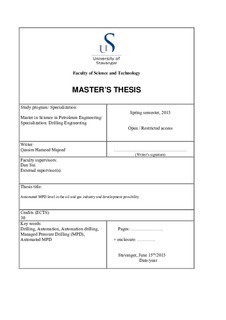Automated MPD level in the oil and gas industry and development possibility
Master thesis
Permanent lenke
http://hdl.handle.net/11250/2504785Utgivelsesdato
2015-06Metadata
Vis full innførselSamlinger
Sammendrag
Automation is introduced to the industrial field long time ago, but still in its first steps in the oil and gas industry. There are many reasons led to this slow of automation in this industry. These reasons related to the industry itself, technical reasons, and human related reasons.
Manage pressure drilling (MPD) is one of the important and advance drilling methods today to solve a lot of drilling problems in high efficiency, safe and economic way.
The automation drilling based on understanding both automation processes and drilling process in design, planning and execution. The automated MPD expected to be the most efficient method of drilling in the next few years both as a drilling operation and as an automation system.
The automated MPD technology faces many limitations and challenges relating to the complexity of the operation itself, the dynamic variable effects the operation, the data acquisition quality, and the crew skills level. These challenges and limitations are detailed illustrated in this thesis to figure out clearly the requirement to develop this advance technology currently and for the future.
The thesis objective is to suggest a general standard automated MPD structure to cover the MPD applications solving the drilling problems facing the drilling operation in different types of wells. Automation models govern the drilling parameters and gives the ability to switch between different MPD application depending on the well type and the drilling problem.
This thesis discusses the current automation system and the current (MPD) method individually. Then discussing the current automated MPD used through some years ago and discussing its limitations and challenges in four different case studies each relating to a specific drilling problem and specific well situation.
This thesis is a step forward to indicate the basement required to build up such a general standard automated MPD structure.
Beskrivelse
Master's thesis in Petroleum Engineering

